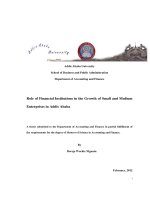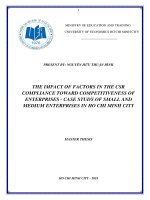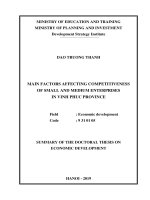Role of Financial Institutions in the Growth of Small and Medium Enterprises in Addis Ababa
Bạn đang xem bản rút gọn của tài liệu. Xem và tải ngay bản đầy đủ của tài liệu tại đây (669.18 KB, 142 trang )
Addis Ababa University
School of Business and Public Administration
Department of Accounting and Finance
Role of Financial Institutions in the Growth of Small and Medium
Enterprises in Addis Ababa
A thesis submitted to the Department of Accounting and Finance in partial fulfillment of
the requirements for the degree of Masters of Science in Accounting and Finance.
By
Dereje Workie Nigussie
February, 2012
i
This thesis is dedicated to my late mother Ejigayehu Andualem
ii
Role of Financial Institutions in the Growth of Small and Medium
Enterprises in Addis Ababa
A thesis submitted to the Department of Accounting and Finance in partial fulfillment of
the requirements for the degree of Masters of Science in Accounting and Finance.
By: Dereje Workie Nigussie
Chairperson (Graduate Committee) Signature
Approved by Board of Examiners:
__________________________
Advisor
_______________________
Examiner
___________________
Signature
__________________
Signature
iii
Statement of Certification
This is to certify that Dereje Workie Nigussie has carried out his research work on the
topic entitled “Role of financial institutions in the growth of small and medium
enterprises in Addis Ababa”.
The work is original in nature and is suitable for
submission for the reward of the Master`s Degree in Accounting and Finance.
Advisor: Wollela A Y (PhD):________________________________
Date: ____________________________
iv
Statement of Declaration
I, the undersigned, declare that this thesis is my original work, has not been presented for
a degree in any other university and that all sources of materials used for the thesis have
been dully acknowledged.
Declared by:
Name: Dereje Workkie Nigussie
Signature: ____________
Date: ________________
v
Abstract
This thesis examines the role of financial institutions, banks and microfinance institutions,
in the growth of small and medium enterprises (SMEs). The study focuses on examining the
contribution of financial institutions, assessing the accessibility and affordability of
products and services, and identifying ways of addressing the problems in accessing and
settling loans.
The study adopts a mixed research approach to test the hypothesis and answer research
questions. Specifically, the study uses survey of SMEs, documentary analysis (documents
held by SMEs), and in-depth interviews with banks managers/officials. The study
statistically analyses the results of survey and documentary analysis while descriptive
research approach was employed for in-depth interviews.
Results show that financial institutions were contributing to SMEs growth. Consequently,
the relationship between loans from financial institutions and SMEs growth are positive
and statistically significant. However, the extents of contribution were very low. Further, it
identifies ways of addressing the problems that SMEs face in accessing and settling loans
include: flexing terms and conditions, using alternative collateral and credit facilities,
refinancing, and postponing maturity period. Finally, the thesis recommends a serious of
measures which should be performed by the government and by financial institutions.
These include: creation of a level playing field, lowering transactional costs, and
commercial banks should reappraise their role.
Key words: role, financial institutions, SMEs growth
vi
Acknowledgments
First and for most, I thank the almighty God for His wisdom and patience that gave me
during my work. I would like to express my heartfelt thanks to my thesis advisor Wollela
Abehodie (PhD) for her invaluable and immeasurable assistance and guidance during my
study. My thanks also go to Addis Ababa University for providing me financial
assistance.
I would also like to give special credit to employees of commercial banks, MFIs and
SMEs for their priceless information that has enriched this study. My thanks also go to
Abel for his editorial comments and all my friends who were with me throughout my
research work.
And finally, I would like to extend my grateful acknowledgements to my family, for their
invaluable encouragement; otherwise it could be a great challenge for me to complete my
study with a great confidence.
vii
Table of contents
Abstracts ......................................................................................................................... vi
Acknowlegements............................................................................................................ vii
Table of contents ........................................................................................................... viii
List of tables .................................................................................................................... xi
List of abbreviations ...................................................................................................... xiii
Chapter One - Introduction ............................................................................................. 1
1.1.
Statement of problems ...................................................................................... 3
1.2.
Research objective, hypothesis and research questions .................................... 5
1.3.
Research methods ............................................................................................. 6
1.4.
Significance of the study................................................................................... 7
1.5.
Scope of the study ............................................................................................. 8
1.6.
Structure of the study ........................................................................................ 9
Chapter Two - Literature Review ................................................................................. 10
2.1.
Theoretical studies .......................................................................................... 10
2.1.1.
Overview of Financial Institutions.............................................................. 11
2.1.1.1.
Role of Banks ...................................................................................... 14
2.1.1.2.
Role of Microfinance institutions ........................................................ 20
2.1.2.
Nature and Importance of SMEs in Economic Development ..................... 22
2.1.2.1.
What is an SME? ................................................................................. 22
2.1.2.2.
Indicators of Growth ............................................................................ 25
viii
2.1.2.3.
General Constraints to SMEs’ Growth ................................................ 27
2.2.
Empirical Review............................................................................................ 30
2.3.
Conclusion and Knowledge Gaps ................................................................... 34
Chapter Three - Research Methodology ...................................................................... 36
3.1.
Hypothesis and Research questions ................................................................ 36
3.2.
Research Approaches ...................................................................................... 39
3.2.1.
Quantitative research approach ................................................................... 40
3.2.2.
Qualitative research approach ..................................................................... 42
3.2.3.
Mixed methods approach ............................................................................ 44
3.3.
Research Methods Adopted ............................................................................ 45
3.3.1.
Quantitative aspect of the study .................................................................. 46
3.3.2.
Qualitative aspect of the study .................................................................... 51
3.3.3.
Data analysis methods................................................................................. 52
Chapter Four - Results and analysis ............................................................................. 57
4.1.
Results ............................................................................................................. 57
4.1.1.
Survey results .............................................................................................. 57
4.1.1.1.
Respondents’ profile ............................................................................ 58
4.1.1.2.
Role of Banks in the Growth of SMEs ................................................ 63
4.1.1.3.
Role of MFIs in the growth of SMEs .................................................. 70
4.1.2.
In-depth interview Results .......................................................................... 77
4.1.2.1.
Bank products and services ................................................................. 77
ix
4.1.2.2.
4.1.3.
4.2.
Microfinance institutions’ products and services ................................ 80
Documentary analysis – regression estimates............................................. 81
Data analysis ................................................................................................... 84
4.2.1.
Research question (RQ1) ............................................................................ 84
4.2.2.
Research question (RQ2) ............................................................................ 89
4.2.3.
Research Question (RQ3) ........................................................................... 92
4.2.4.
Research question (RQ4) ............................................................................ 94
4.2.5.
Hypothesis (H) ............................................................................................ 97
Chapter Five - Conclusions .......................................................................................... 100
5.1.
Overview of the thesis and its major findings .............................................. 100
5.2.
The implications of these findings ................................................................ 106
5.3.
Limitations and further research directions .................................................. 107
References ...................................................................................................................... 109
Appendix 1 - SMEs survey instrument (English version) ......................................... 115
Appendix 2 - SMEs Survey instrument (Amharic Version) ..................................... 122
Appendix 3 - In-depth interviews questions ............................................................... 129
x
List of tables
Table 4.1 Respondents’ level of education ...................................................................... 58
Table 4.2 Respondents’ current position ......................................................................... 59
Table 4.3 Respondents by years work of experience ....................................................... 59
Table 4.4 Age of business ................................................................................................ 60
Table 4.5 Types of business activity................................................................................. 60
Table 4.6 Busines ownership form ................................................................................... 61
Table 4.7 Business by number of employees .................................................................. 61
Table 4.8 Business by level of market competition .......................................................... 62
Table 4.9 SMEs by annual sales for 2009/10 fiscal year ................................................. 62
Table 4.10 SMEs by export to total sales ratio in 2009/10 fiscal year ............................. 63
Table 4.11 Access to banks loans ..................................................................................... 63
Table 4.12 Reasons for not having access to bank loans .................................................. 64
Table 4.13 Bank loans applying and received .................................................................. 64
Table 4.14 Bank loans maturity periods ........................................................................... 65
Table 4.15 Bank loans criteria .......................................................................................... 66
Table 4.16 Simplicity of bank loans criteria ..................................................................... 66
Table 4.17 Adequacy of bank loans.................................................................................. 67
Table 4.18 Purposes of bank loans .................................................................................. 67
Table 4.19 SMEs that face problems in paying back bank loans ..................................... 68
Table 4.20 Additional services offered by banks ............................................................ 69
xi
Table 4.21 Special products and services offered by banks ............................................ 69
Table 4.22 Access to MFIs loans ...................................................................................... 70
Table 4.23 MFIs loan maturity periods ............................................................................ 71
Table 4.24 Simplicity of MFIs loans criteria .................................................................... 71
Table 4.25 Reasons for not having access to MFIs loans ................................................. 72
Table 4.26 MFIs loans criteria .......................................................................................... 73
Table 4.27 Adequacy of MFIs loans ................................................................................ 73
Table 4.28 Purposes of MFIs loans ................................................................................. 74
Table 4.29 SMEs that face problems in paying back MFIs loans .................................... 74
Table 4.30 Additional services offered by MFIs .............................................................. 75
Table4.31 Source of finance to meet workingcapital requirement ................................. 76
Table4.32 Source of finance for medium and long term investment ................................ 76
Table 4.33 Descriptive statistics ...................................................................................... 81
Table 4.34 Regression results .......................................................................................... 82
xii
List of abbreviations
CSA
Central Statistics Authority
ETB
Ethiopian birr
ERCA
Ethiopian Revenue and Custom Authority
EC
European Commission
LDCs
Least Developing Countries
MFIs
Microfinance Institutions
OLS
Ordinary Least Square
SMEs
Small and Medium Enterprises
SD
Standard Deviation
UNIDO
United Nation Industrial Development Organization
xiii
Chapter One
Introduction
Small and Medium enterprises (SMEs) and financial institutions are vital contributors to
the overall performance of an economy. SMEs play a crucial role in developing the
economy and in creating employment. They do not only provide employment and income
opportunities to a large number of people, but also are at the forefront of technological
innovations and export diversification. Similarly, financial institutions play an
indispensable role in firm’s growth and thus industry productivity and economic growth.
They provide a sound medium of exchange and facilitate trading, encourage mobilization
of resources through savings and allocate resources to activities with highest returns,
monitor investments and exert corporate governance, and spreads risks by offering a
diversity of financial instruments. Furthermore, they provide financial assistance to fulfil
the varied needs of enterprises.
Zeller (2003) broadly defined financial institution as an organization, which may be
either for-profit or nonprofit, that takes money from clients and places it in any of a
variety of investment vehicles for the benefit of both the client and the organization.
Common examples of financial institutions are banks, insurance companies, credit
Associations, microfinance, financial and economic firms.
The term SMEs covers a wide range of definitions and measures, varying from country to
country and between the sources reporting SME statistics. Although there is no
1
Chapter 1 Introduction
universally agreed definition of SME some of the commonly used criteria are the number
of employees, value of assets, value of sales and size of capital or turnover. However, the
most common basis of defining SMEs is number of employees (Nugent, 2001).
Whatever the definition, and regardless of the size of the economy, the growth of SMEs
is becoming increasingly crucial to economic growth. The issue of SMEs development
ranks high among the priorities of socio-economic development, given the growing need
for employment creation and poverty alleviation (Nugent, 2001). Nugent (2001) further
noted that there is also an urgent need to create a strong competitive SMEs sector that is
able to play a leading role in the development process.
In dealing with the development of SMEs, financial institutions are one essential organ.
Therefore, access to financial services and institutions is a critical element for SMEs
growth. However, there appears to be limited evidence that confirms the contribution of
financial institutions for SMEs growth. To this end, this study is significantly place as its
main focus, the examination of financial institutions role in SMEs growth in Ethiopia,
particularly in Addis Ababa.
The purpose of this chapter is to provide background information on the study. The
balance of the chapter is organized as follows. The first section sets out statement of
problems. The second section provides the research objective. The research methods used
is presented in section three. Significance and scope of the study are presented in section
four and five respectively. Finally, the structure of the thesis is presented in section six.
2
Chapter 1 Introduction
1.1.
Statement of problems
Obviously, SMEs constitute the backbone of an economy. The SMEs sector plays a vital
role in the industrial development of the country. World Bank (1994) indicated that
industrial development was earlier believed to have occurred because of large enterprises.
However, starting in the late 1970s and early 1980s, SMEs have become perceived as the
key agent for industrialization. It is recognised that this sector provides not only
employment opportunities to an increasing number of people in the country, but it is also
an effective means of fighting poverty and income inequality. At the same time, SMEs
serve as a training ground for emerging entrepreneurs. It is within this context that SMEs
development became focal attention for governmental as well as nongovernmental
organizations. This requires bringing the specific needs of the enterprise to the center of
the policy-making process, and recognizing that SMEs are to be assisted not because they
are small, but because of their capability to be efficient, innovative and able to compete
in the local and international markets.
However, as Albaladejo (2001) noted, in the majority of developing countries, most
SMEs’ activities are undertaken in the informal sector even though they play a major role
in economic growth. They use their own saving, reinvestment of profits, and own labor as
the main sources for their development. Despite these, their sustainable growth will
largely depend on the capacity of financial institutions to mobilize resources from low
valued to high valued and invest in SMEs activities.
3
Chapter 1 Introduction
Since SMEs’ sector does have a very significant role in the Ethiopian economy, the
government was striving to create competitive and productive SME sector. It is for this
reason that the Ethiopian government develops policy so as to address the constraints and
to tap the full potential of the sector. This policy will serve as guidelines to all
stakeholders and thus stimulate new enterprises to be established and existing ones to
grow and become more competitive. When a company is growing rapidly its current
financial resources may be inadequate. Few growing companies are able to finance their
expansion plans from cash flow alone. They will therefore need to consider raising
finance from other external sources. In support of this, the Ethiopia government, in order
to provide adequate supply of financial services to various sectors of the economy,
especially to small business, has evolved a wide variety of financial institutions both at
the national and regional level as an effective means of fighting poverty and income
inequality. Therefore, it is absolutely essential that the financial institutions should
contribute for the development of SMEs not only quickly but also at a minimal cost.
However, as shown in the literature review in the next chapter, there appears to be limited
evidence that confirms the contribution of financial institutions for SMEs growth. In
Ethiopian context, there appears to be no attempt to investigate role of financial
institutions on SME growth. Therefore, the deficiencies of the previous studies along
with the above discussed issues called for the current research.
4
Chapter 1 Introduction
1.2.
Research objective, hypothesis and research questions
In the context of the problems highlighted above, the broad objective of this study is to
investigate the role of financial institutions, with a particular focus on banks and MFIs,
on the growth of SMEs in Ethiopia, particularly in Addis Ababa by using disaggregated
data. The study was focused on the SMEs growth and to investigate the extent to which
financial institutions may have contributed to this SMEs growth.
To achieve this general objective, one hypothesis and four research questions were
developed.
Ho: Loan from financial institutions, banks and MFIs, does not foster SMEs
growth.
H1: Loan from financial institutions, banks and MFIs, contributes significantly to
SMEs growth.
In addition to the above hypothesis the study has developed the following four research
questions.
RQ1. What roles do financial institutions, specifically banks and MFIs, play in SMEs
growth?
RQ2. What forms of financing are available in financing working capital as well as
medium & long-term loan requirements of SMEs?
5
Chapter 1 Introduction
RQ3. Are the financial institutions products and services, accessible and affordable
for the SMEs?
RQ4. How do financial institutions address the problems that SMEs face in the
process of accessing and settling loans?
1.3.
Research methods
To achieve the above research objective a mixed research approach is adopted. The main
reason of using such approach is to alleviate the limitations of quantitative and qualitative
research approaches and to gather data that could not be obtained by adopting a single
method. Thus, the thesis uses cross sectional survey of SMEs with semi-structured
questionnaire, documentary analysis (documents held bay SMEs), and in-depth interview
with banks and MFIs managers/officials.
The survey contains both open and close ended questions and administered through
distribution of questionnaires to SMEs. The purpose of survey is to gather data which is
not available from other sources and for standardization of measurement. In order to seek
clarifications and the related products and services that financial institutions have indepth interviews were held with banks and MFIs managers/officials. Apart from survey
of SMEs and in-depth interviews with banks and MFIs managers/officials, the study was
used documentary analysis to obtain other facts that may not be obtained through
interviews and administering of questionnaire.
6
Chapter 1 Introduction
Regards to results and analysis, the responses obtained from survey of SMEs was
tabulated and interpreted by using descriptive statistics while descriptive research was
used to present the outcomes of in-depth interviews with banks and MFIs
managers/officials. Finally, the study concurrently analyzes survey and in-depth
interviews results to answer a series of research questions and multiple OLS regression
analysis to test the hypothesis.
1.4.
Significance of the study
Yet until now, there appeared to be no attempt to investigate the role of financial
institutions in the promotion of SMEs in Ethiopia. Therefore, this study is the first to
provide a comprehensive approach to the understanding of role of financial institutions
and will intend to fill the gap in this arena.
Generally, this study contributes to the knowledge in many important areas of financial
institutions and SMEs studies. Firstly, it advances to a better understanding of functions
and roles of financial institutions, secondly, it increases the understanding of how
financial institutions influences the development of SMEs and, third, it will pave the way
forward for the government, policy makers, financial institutions and to the general
public at large to understand the different roles of financial institutions in the enterprises
development process.
7
Chapter 1 Introduction
Currently, the Ethiopian government gives due emphasis to micro, small, and medium
enterprises establishment and development. The establishment of these enterprises would
eventually lead to the transfer of appropriate technology and its adaption to suit the
environment. This requires bringing the specific needs of the enterprises to the center of
the policy-making process In Ethiopia, perhaps the most important challenge facing
policy makers in industrial development is the financing and technological upgrading of
the myriad of SMEs that formed the back bone of industry and provide the bulk of
employment and income generation. To this end, the current government of Ethiopia has
continued to articulate policy measures and programme to achieve micro, small, and
medium enterprises development, through appropriate alternative funding. The main
sources of funding typically are financial institutions. Therefore, this study is
significantly devoted or place as its main focus, the examination of the financial
institutions role in SMEs growth.
Finally, this study will also be used as a basis for any future study that will examine the
relationship between financial institutions and enterprises and for those who further needs
to explore on some other concerns of SMEs.
1.5.
Scope of the study
This research entirely focuses on the role of financial institutions in the growth of SMEs,
particularly in Addis Ababa but, no attempt was made to take any other segment of the
country. The current study further limits itself from those other functions of financial
8
Chapter 1 Introduction
institutions. Thus any functions of financial institutions that they play in the other aspect
of economic growth of the country were not the concern of this study. It is also worth
mention that this research thesis was not being entirely about SMEs instead, it only
investigate the contribution of financial institution for their growth.
1.6.
Structure of the study
This research involves five chapters. Chapter one presents background, problem
statement, objectives of the research, significance, and scope of the study. Chapter two
contains a review of the literature. The research methodology is presented in chapter
three. Chapter four presents the results of the different methods used and analysis.
Finally, chapter five presents conclusions.
9
Chapter Two
Literature Review
This chapter reviews the theoretical and empirical literature on the role of financial
institutions in the growth of SMEs. This review of the literature establishes the
framework for the current study and provides the deficiencies of the previous studies,
which in turn, help in clearly identifying the gap in the literature and formulating research
questions for the study.
The review has three sections. Section one presents a theoretical review of role of
financial institutions and SMEs development. This is followed by a review of the relevant
empirical studies on financial institutions role in the development of SMEs. Finally,
conclusions and knowledge gaps are presented in section three.
2.1.
Theoretical studies
This section briefly sketches different types of financial institutions which have proven
effective in providing services to SMEs. These are banks and MFIs. The section opens
with an overview of financial institutions. This shows the various products and services
that financial institutions have and explain the theoretical role of banks and MFIs to the
development of firms. These give an idea on how financial institutions contribute to the
development of SMEs. Finally, the concern is to show the nature, importance, measures
of growth and constraints of SMEs.
10
Chapter 2 Literature review
2.1.1. Overview of Financial Institutions
The European Community programme of policy and action for sustainable development
(1993, p.27) recognized the importance of financial institutions by stating that "financial
institutions which assume the risk of companies and can exercise considerable influence in some cases control over investment and management decisions which could be brought
into play for the benefit of the environment". On a more practical level, financial
institutions interact with the environment in a number of ways:
•
as investors: supplying the investment needed to achieve sustainable
development;
•
as innovators: developing new financial products to encourage sustainable
development;
•
as valuers: pricing risks and estimating returns, for companies, projects and
others;
•
as powerful stakeholders: as shareholders and lenders they can exercise
considerable influence over the management of companies;
•
as polluters: while not “dirty” industries, financial institutions do consume
considerable resources;
•
as victims of environmental change: e.g. from climate change
11
Chapter 2 Literature review
As Amina (2009) noted the financial sector can have more impact on firms’ growth in
two ways: firstly, a well-developed financial system allows the firms to have access to
financial services, which they are often denied. They need to have access to a large array
of financial services, such as saving facilities, payment instruments, credit, and insurance.
Secondly, the financial sector can also contribute to firm’s growth indirectly, as a
diversified and competitive financial sector plays an important role in economic
development generally. Indeed, a well-functioning financial sector contributes to the
maintenance of economic stability; it provides a means of payment and makes possible
secure financial and commercial transactions; it helps to mobilize domestic and external
savings; and it is crucial for the efficient allocation of capital to productive investments.
In order for firms to benefit from economic growth, the SMEs need to have access to
products/services which is provided by financial institutions.
The common products that financial institutions provide includes: credit, savings,
insurance, credit cards, cash management, and payment services. These points are briefly
described each as follows:
Credit: These are borrowed funds with specified terms for repayment. People borrow
when there are insufficient accumulated savings to finance a business. They also take into
consideration if the return on borrowed funds exceeds the interest rate charged on the
loan and if it is advantageous to borrow rather than to postpone the business operations
until when it is possible to accumulate sufficient savings (Waterfield and Duval, 1996).
12









